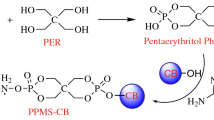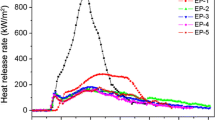Abstract
A novel polyphosphazene (PZS)-wrapped iron 2-methylimidazole metal–organic framework (PZS–Fe–MOF) hybrid with rich N, P, and Fe elements is synthesized, which is incorporated into epoxy resin (EP) to prepare EP/PZS–Fe–MOF composites for improving flame retardancy and smoke suppression of EP via synergistic effect. The results indicate that PZS–Fe–MOF significantly enhances the flame retardant and smoke suppression performances of EP composites. Compared with pure EP, with the addition of 1 mass% PZS–Fe–MOF, the LOI value is increased from 32.3 to 25.8% and EP/1 mass% PZS–Fe–MOF composites pass V-1 rating. Compared with pure EP, the peak heat release rate, total heat release, smoke production rate, and total smoke production of EP/3 mass% PZS–Fe–MOF composites are decreased by 30.2%, 36.9%, 36.6%, and 41.4%, respectively. The results indicate that the improved flame retardancy and smoke suppression are mainly attributed to that the synergistic effect between PZS and Fe-MOF, promoting the formation of compact carbonaceous ceramic layer, which can restrain heat and mass transfer between EP composites and flame zone.







Similar content being viewed by others
References
Zhou KQ, Tang G, Gao R, Jiang SD. In situ growth of 0D silica nanospheres on 2D molybdenum disulfide nanosheets: towards reducing fire hazards of epoxy resin. J Hazard Mater. 2018;344:1078–89.
Zhang JH, Kong QH, Wang DY. Simultaneously improving fire safety and mechanical properties of epoxy resin by Fe–CNTs via large-scale preparation. J Mater Chem A. 2018;6:6376–86.
Xu WZ, Wang XL, Wu Y, Li W, Chen CY. Functionalized graphene with Co–ZIF adsorbed borate ions as an effective flame retardant and smoke suppression agent for epoxy resin. J Hazard Mater. 2019;363:138–51.
Zhang X, Yan XR, Guo J, Liu Z, Jiang DW, He QL, Wei HG, Gu HB, Colorado HA, Zhang XY, Wei SY, Guo ZH. Polypyrrole doped epoxy resin nanocomposites with enhanced mechanical properties and reduced flammability. J Mater Chem C. 2015;3:162–76.
Zhou T, Wu T, Xiang HN, Li ZC, Xu ZL, Kong QH, Zhang JH, Li Z, Pan YT, Wang DY. Simultaneously improving flame retardancy and dynamic mechanical properties of epoxy resin nanocomposites through synergistic effect of zirconium phenylphosphate and POSS. J Therm Anal Calorim. 2019;135:2117–24.
Xu WZ, Zhang BL, Wang XL, Wang GS, Ding D. The flame retardancy and smoke suppression effect of a hybrid containing CuMoO4 modified reduced graphene oxide/layered double hydroxide on epoxy resin. J Hazard Mater. 2018;343:364–75.
Zhang JH, Kong QH, Yang LW, Wang DY. Few layered Co(OH)2 ultrathin nanosheet-based polyurethane nanocomposites with reduced fire hazard: from eco-friendly flame retardance to sustainable recycling. Green Chem. 2016;18:3066–74.
Jiao CM, Wang HZ, Chen XL, Tang GW. Flame retardant and thermal degradation properties of flame retardant thermoplastic polyurethane based on HGM@[EOOEMIm][BF4]. J Therm Anal Calorim. 2019;135:3141–52.
Li QX, Shi C, Huang ML, Wei X, Yan H, Yang CL, Yuan AH. B- and N-embedded color-tunable phosphorescent iridium complexes and B-N Lewis adducts with intriguing structural and optical changes. Chem Sci. 2019;10:3257–63.
Sun HZ, Tang BB, Wu PY. Two-dimensional zeolitic imidazolate framework/carbon nanotube hybrid networks modified proton exchange membranes for improving transport properties. ACS Appl Mater Inter. 2017;9:35075–85.
Barbosa P, Rosero-Navarro NC, Shi FN, Figueiredo FML. Protonic conductivity of nanocrystalline zeolitic imidazolate framework 8. Electrochim Acta. 2015;153:19–27.
Li WB, Zhang YF, Li QB, Zhang GL. Metal-organic framework composite membranes: synthesis and separation applications. Chem Eng Sci. 2015;135:232–57.
Zeng L, Guo XY, He C, Duan CY. Metal-organic frameworks: versatile materials for heterogeneous photocatalysis. ACS Catal. 2016;6:7935–47.
Wang CR, Liu BS, Sun FX, Xie JJ. New challenge of microporous metal-organic frameworks for adsorption of hydrogen fluoride gas. Mater Lett. 2017;197:175–9.
Lee YR, Jang MS, Cho BY, Kwon HJ, Kim S, Ahn WS. ZIF-8: a comparison of synthesis methods. Chem Eng J. 2015;271:276–80.
Zhang JH, Huang M, Xi BJ, Mi K, Yuan AH, Xiong SL. Systematic study of effect on enhancing specific capacity and electrochemical behaviors of lithium–sulfur batteries. Adv Energy Mater. 2018;8:201701330.
Shi XW, Dai X, Cao Y, Li JW, Huo CG, Wang XL. Degradable poly(lactic acid)/metal-organic framework nanocomposites exhibiting good mechanical, flame retardant, and dielectric properties for the fabrication of disposable electronics. Ind Eng Chem Res. 2017;56:3887–94.
Hou YB, Hu WZ, Gui Z, Hu Y. Vertically aligned nickel 2-methylimidazole metal-organic framework fabricated from graphene oxides for enhancing fire safety of polystyrene. Ind Eng Chem Res. 2017;56:2036–45.
Hu Y, Meng LJ, Niu LY, Lu QH. Facile synthesis of superparamagnetic Fe3O4@polyphosphazene@Au shells for magnetic resonance imaging and photothermal therapy. ACS Appl Mater Inter. 2013;5:4586–91.
Jin W, Yuan L, Liang G, Gu A. Multifunctional cyclotriphosphazene/hexagonal boron nitride hybrids and their flame retarding bismaleimide resins with high thermal conductivity and thermal stability. ACS Appl Mater Inter. 2014;6:14931–44.
Chen C, Liu X, Tian Z, Allcock HR. Trichloroethoxy-substituted polyphosphazenes: synthesis, characterization, and properties. Macromolecules. 2012;45:9085–91.
Tian ZC, Hess A, Fellin CR, Nulwala H, Allcock HR. Phosphazene high polymers and models with cyclic aliphatic side groups: new structure-property relationships. Macromolecules. 2015;48:4301–11.
Tarassoli A, Sedaghat T, Ansari-Asl Z. Surface functionalization of phosphazenenanosphere derivatives by Schiff-base-assisted metal complexes through a Si-spacer. J Ind Eng Chem. 2014;20:2287–91.
Mayer-Gall T, Knittel D, Gutmann JS, Opwis K. Permanent flame retardant finishing of textiles by allyl-functionalized polyphosphazenes. ACS Appl Mater Inter. 2015;7:9349–63.
Zhu L, Zhu Y, Pan Y, Huang Y, Huang X, Tang X. Fully crosslinked poly [cyclotriphosphazene-co-(4,4′-sulfonyldiphenol)] microspheres via precipitation polymerization and their superior thermal properties. Macromol React Eng. 2007;1:45–52.
Liu H, Wang XD, Wu DZ. Novel cyclotriphosphazene-based epoxy compound and its application in halogen-free epoxy thermosetting systems: synthesis, curing behaviors, and flame retardancy. Polym Degrad Stabil. 2014;103:96–112.
Fu JW, Huang XB, Huang YW, Zhang JW, Tang XZ. One-pot noncovalent method to functionalize multi-walled carbon nanotubes using cyclomatrix-type polyphosphazenes. Chem Commun. 2009;9:1049–51.
Fu JW, Xu Q, Chen JF, Chen ZM, Huang XB, Tang XZ. Controlled fabrication of uniform hollow core porous shell carbon spheres by the pyrolysis of core/shell polystyrene/cross-linked polyphosphazene composites. Chem Commun. 2010;46:6563–5.
Zhou X, Qiu SL, Xing WY, Gangireddy CSR, Gui Z, Hu Y. Hierarchical polyphosphazene@molybdenum disulfide hybrid structure for enhancing the flame retardancy and mechanical property of epoxy resins. ACS Appl Mater Inter. 2017;9:29147–56.
Zhang C, Gu XD, Ma SM, Liu XR, Xu JZ, Ma HY. Synthesis of an organic-inorganic hybrid strontium hydroxystannate nanorod and application as novel flame retardant. Mater Lett. 2018;229:297–300.
Dong TW, Deng T, Chu XY, Qin TT, Wang HX, Wang ZZ, Zhang W, Zheng WT. Carbon intermediate boosts Fe–ZIF derived alpha-Fe2O3 as high-performance negative electrode of supercapacitors. Nanotechnology. 2019. https://doi.org/10.1088/1361-6528/ab5baf.
Huang M, Mi K, Zhang JH, Liu HL, Yu TT, Yuan AH, Kong QH, Xiong SL. MOFs-derived bi-metal embedded N-doped carbon polyhedral nanocages with enhanced lithium storage. J. Mater. Chem. A. 2017;5:266–74.
Lin KYA, Lee WD. Self-assembled magnetic graphene supported ZIF-67 as a recoverable and efficient adsorbent for benzotriazole. Chem Eng J. 2016;284:1017–27.
Hu X, Yan X, Zhou M, Komarneni S. One-step synthesis of nanostructured mesoporous ZIF-8/silica composites. Micropor Mesopor Mat. 2016;219:311–6.
Schejn A, Balan L, Falk V, Aranda L, Medjahdi G, Schneider R. Controlling ZIF-8 nano- and microcrystal formation and reactivity through zinc salt variations. CrystEngCommun. 2014;16:4493–500.
Kong QH, Wu T, Zhang HK, Zhang Y, Zhang MM, Si TY, Yang L, Zhang JH. Improving flame retardancy of IFR/PP composites through the synergistic effect of organic montmorillonite intercalation cobalt hydroxides modified by acidified chitosan. Appl Clay. 2017;146:230–7.
Li Z, Wang DY. Nano-architectured mesoporous silica decorated with ultrafine Co3O4 toward an efficient way to delaying ignition and improving fire retardancy of polystyrene. Mater Des. 2017;129:69–81.
Wan JT, Gan B, Li C, Molina-Aldareguia J, Li Z, Wang X, Wang DY. A novel biobased epoxy resin with high mechanical stiffness and low flammability: synthesis, characterization and properties. J Mater Chem A. 2015;3:21907–21.
Kong QH, Sun YL, Zhang CJ, Guan HM, Zhang JH, Wang DY, Zhang F. Ultrathin iron phenyl phosphonate nanosheets with appropriate thermal stability for improving fire safety in epoxy. Compos Sci Technol. 2019;182:107748.
Yan YW, Chen L, Jian RK, Kong S, Wang YZ. Intumescence: an effect way to flame retardance and smoke suppression for polystyrene. Polym Degrad Stab. 2012;97:1423–31.
Zhou KQ, Liu JJ, Zeng WR, Hu Y, Gui Z. In situ synthesis, morphology, and fundamental properties of polymer/MoS2 nanocomposites. Compos Sci Technol. 2015;107:120–8.
Zhou KQ, Gao R, Qian XD. Self-assembly of exfoliated molybdenum disulfide (MoS2) nanosheets and layered double hydroxide (LDH): towards reducing fire hazards of epoxy. J Hazard Mater. 2017;338:343–55.
Li Z, Zhang JH, Dufosse F, Wang DY. Ultrafine nickel nanocatalyst-engineering of an organic layered double hydroxide towards a super-efficient fire-safe epoxy resin via interfacial catalysis. J Mater Chem A. 2018;6:8488–98.
Kong QH, Wu T, Zhang JH, Wang DY. Simultaneously improving flame retardancy and dynamic mechanical properties of epoxy resin nanocomposites through layered copper phenylphosphate. Compos Sci Technol. 2018;154:136–44.
Zhou DF, He WD, Wang N, Chen XL, Guo JB, Ci ST. Effect of thermo-oxidative aging on the mechanical and flame retardant properties of long glass fiber-reinforced polypropylene composites filled with red phosphorus. Polym Compos. 2018;39:2634–42.
Wang X, Zhou S, Guo WW, Wang PL, Xing WY, Song L, Hu Y. Renewable cardanol-based phosphate as a flame retardant toughening agent for epoxy resins. ACS Sustain Chem Eng. 2017;5:3409–16.
Zheng L, Wu T, Kong QH, Zhang JH, Liu H. Improving flame retardancy of PP/MH/RP composites through synergistic effect of organic CoAl-layered double hydroxide. J Therm Anal Calorim. 2017;129:1039–46.
Wu T, Kong QH, Zhang HK, Zhang JH. Thermal stability and flame retardancy of polypropylene/NiAl layered double hydroxide nanocomposites. J Nanosci Nanotechnol. 2018;18:1051–6.
Liu L, Zhang HK, Sun L, Kong QH, Zhang JH. Flame-retardant effect of montmorillonite intercalation iron compounds in polypropylene/aluminum hydroxide composites system. J Therm Anal Calorim. 2016;124:807–14.
Acknowledgements
This research is funded by the National Natural Science Foundation of China (51603091) and Zhenjiang 2019 Cable Fire Protection Enhancement Special Consultation Project (HYDL-ZJ-201903-01-079).
Author information
Authors and Affiliations
Corresponding authors
Additional information
Publisher's Note
Springer Nature remains neutral with regard to jurisdictional claims in published maps and institutional affiliations.
Ru Yang’s contribution is the formulation and implementation of experimental schemes. Qinghong Kong and Junhao Zhang put forward research ideas, revised papers, and provided research funding.
Rights and permissions
About this article
Cite this article
Sang, L., Cheng, Y., Yang, R. et al. Polyphosphazene-wrapped Fe–MOF for improving flame retardancy and smoke suppression of epoxy resins. J Therm Anal Calorim 144, 51–59 (2021). https://doi.org/10.1007/s10973-020-09481-6
Received:
Accepted:
Published:
Issue Date:
DOI: https://doi.org/10.1007/s10973-020-09481-6




